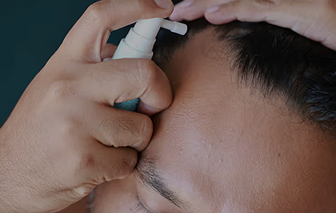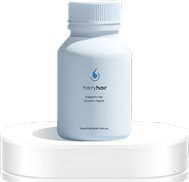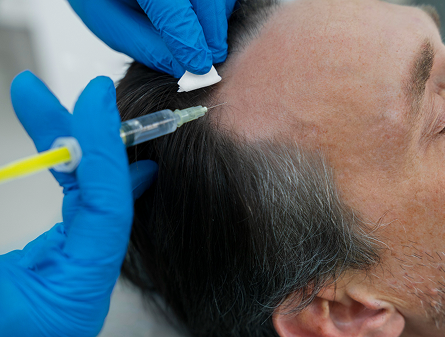Dutasteride is a treatment for pattern hair loss that works by blocking dihydrotestosterone (DHT). This hormone is responsible for the shrinking of hair follicles which leads to hair loss. Hair loss shampoo can potentially help to regrow your hair.
The effectiveness of the treatment can depend on the ingredients used as well as if they can help with your cause of hair loss. Dutasteride is a prescription medication that can be prescribed off-label to help with hair loss since it is only approved as a hair loss treatment in Japan and South Korea.
Hair loss shampoos are usually not board-certified solutions but the natural ingredients used can help to promote hair growth thanks to different properties. Discover the differences between dutasteride and hair loss shampoo in the comparison table below.
- Dutasteride is a prescription oral medication that blocks all three types of 5-alpha reductase.
- Unlike hair loss shampoo, it targets the hormonal source of male pattern baldness.
- Hair loss shampoo is a topical treatment that may reduce shedding and support scalp health.
- Compared to dutasteride, it does not alter hormones but works externally.
- Dutasteride costs approximately $40–$80 monthly and requires a prescription.
- Higher long-term expenses due to medical consultations and ongoing use.
- Hair loss shampoos cost around $10–$40 per bottle and are used multiple times weekly.
- Unlike dutasteride, they are more budget-friendly but require frequent resupply.
- Dutasteride is taken daily and typically produces results in 3–6 months.
- Dutasteride needs to be used continuously to see improvements.
- Hair loss shampoo is used regularly as part of a routine, with effects appearing gradually.
- Compared to dutasteride, results are less pronounced and take longer to show.
- Dutasteride is a systemic oral treatment that lowers DHT levels throughout the body.
- It works through a single daily pill that doesn’t interfere with routines.
- Hair loss shampoo is applied to the scalp, lathered, and rinsed off.
- Unlike dutasteride, it acts topically and offers surface-level benefits.
- Dutasteride may cause side effects such as hormonal changes or reduced libido compared with hair loss shampoo.
- It requires supervision and regular assessment.
- Hair loss shampoo is generally safe, but it can cause irritation or dryness for sensitive users.
- Compared to dutasteride, it carries fewer systemic risks.
- Dutasteride is taken once daily and requires no effort beyond swallowing.
- Very simple once prescribed, but may necessitate check-ups to monitor progress and potential side effects.
- Hair loss shampoo is used multiple times weekly and fits easily into hair care routines.
- Unlike dutasteride, it doesn’t require prescriptions or ongoing management.
- Dutasteride is prescription-only and not always approved for hair loss in Australia.
- Less accessible due to medical restrictions.
- Hair loss shampoo is widely available in pharmacies and supermarkets.
- More accessible than dutasteride and doesn’t require professional advice.
- Dutasteride provides results in the long term, but only while taken.
- Hair loss resumes if discontinued.
- Hair loss shampoo helps maintain scalp health and may reduce shedding.
- Compared to dutasteride, results are more subtle and can only provide a short-term benefit.
- Dutasteride is often paired with topical minoxidil or supportive products.
- Compatible with hair loss shampoos as part of a multi-step routine.
- Hair loss shampoo can be combined with medications like dutasteride or finasteride.
- Unlike dutasteride, it is a secondary support for hair loss treatment.
- Dutasteride appeals to users wanting a strong, targeted approach to hair loss.
- Seen as clinical and practical.
- Hair loss shampoo appeals to those seeking a convenient, non-invasive option.
- Compared to dutasteride, it feels less intense and easier to trial.
- Dutasteride may help with prostate conditions in men and reduce DHT levels systemically.
- Focuses on hormonal balance.
- Hair loss shampoo may improve scalp hygiene and reduce inflammation.
- Unlike dutasteride, it does not affect internal health systems.
- Dutasteride generates consistent waste from monthly packaging and prescriptions.
- Dutasteride’s long-term use contributes to pharmaceutical waste.
- Hair loss shampoo creates ongoing plastic waste from bottles.
- Compared to dutasteride, the environmental impact is similar and recurring, but eco-friendly options are available.
Shop our hair solutions
We are committed to providing affordable hair regeneration services for people all over Australia. Our formula can help you regain your confidence.
Shop Now

Dutasteride vs Shampoo For Regrowth Solutions Comparison Summary
Dutasteride is an effective treatment for pattern hair loss that can provide long-lasting prevention of progressive hair loss and encourage healthy hair growth within 6 months. It is more potent than other DHT blockers like finasteride since it blocks all three isoenzymes responsible for the conversion of testosterone into DHT.
Hair loss shampoo effectiveness can depend on the quality of the ingredients used and whether it can help with your form of hair loss, whether that is improving scalp health, reducing inflammation or altering hormones. Dutasteride can be more expensive than finasteride and harder to access since it must be prescribed off-label for helping to tackle hair loss.
Hair loss shampoo costs will depend on the quality of the formulation and the ongoing cost will be determined by how often you need to use the treatment. Dry hair types will not need to use hair loss shampoo as often while oily hair types may require more frequent application which will impact how often you need to purchase the product.
User Guidance
Dutasteride comes with some potential side effects as a systemic treatment relating to sexual function. These include decreased libido, ejaculation issues, and impotence. Research has indicated that these side effects only occur in less than 1 per cent of patients, however. Hair loss shampoos can cause side effects that negatively interact with our endocrine system.
They can activate estrogen receptors and inhibit testosterone receptors causing breast growth. Other potential side effects of hair loss shampoos include irritation, initial hair shedding, hair texture changes, scalp pustules, itching, burning, and contact dermatitis.
Dutasteride is designed to be used as a long-term treatment and is often prescribed off-label if you have already tried finasteride and have not seen significant results. Hair loss shampoo results may be more temporary as benefits can be washed out in hair-thickening products.
Take Our Hair Loss Quiz to See Which Treatment Suits You?
Take A Hair Quiz

Frequently Asked Questions
We have put some commonly asked questions.
Nunc scelerisque tincidunt elit. Vestibulum non mi ipsum. Cras pretium suscipit tellus sit amet aliquet. Vestibulum maximus lacinia massa nontor.
Platelet-rich plasma (PRP) treatment involves drawing blood from the patient, isolating the beneficial nutrients and injecting it into the scalp where hair loss is occurring. This promotes hair growth and has many other applications from encouraging healing to skin rejuvenation.
Platelet-rich plasma (PRP) treatment involves drawing blood from the patient, isolating the beneficial nutrients and injecting it into the scalp where hair loss is occurring. This promotes hair growth and has many other applications from encouraging healing to skin rejuvenation.
Platelet-rich plasma (PRP) treatment involves drawing blood from the patient, isolating the beneficial nutrients and injecting it into the scalp where hair loss is occurring. This promotes hair growth and has many other applications from encouraging healing to skin rejuvenation.







 See All
See All